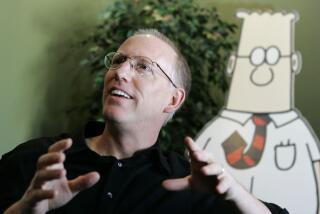Office Funnies
- Share via
Scott Adams is an avowed realist. That’s why his popular cartoon strip “Dilbert” takes such a cynical view of management.
“I once read a definition of the word ‘cynical,’ ” Adams says, “and it said that someone who is cynical sees things as they really are. That’s about right, I think.”
In a world where employees are urged toward “empowerment” one moment and “reengineered” out of jobs the next, Adams’ strip, which lampoons the absurdities of modern corporate life with its Orwellian doublespeak, has struck a quivering nerve among the nation’s 35 million office workers. Now syndicated in nearly 500 newspapers nationwide and available online, Adams is bombarded with up to 300 e-mail messages daily from readers who rant, rave and recommend new plot lines based on their own office travails.
Many of those suggestions become fodder for strips about the continuing adventures of hapless engineer Dilbert, his Machiavellian sidekick Dogbert, pathetically eager corporate grunt Ratbert and a menagerie of other characters who pop in and out of the strip.
But Adams says the biggest chunk of e-mail traffic--and invective--is reserved for Dilbert’s supervisor, The Boss, whom Adams has left generic and nameless so “people can project their own images onto him.”
The Boss has evolved over time. He now has two hairy horns sprouting like carbuncles from his otherwise bald head.
“He used to have two patches of hair, but over time they rose and got pointy on their own, and when I realized that I started exaggerating it,” Adams says. “I liked the vague satanic implications that seemed to fit him so well.”
Indeed, a recurring theme that runs through daily episodes of “Dilbert” as well as conversations with its creator is that there’s no such thing in the leaner, meaner ‘90s as a good boss or a nurturing work environment.
“Ten years ago, you’d be willing to work with abuse, low pay and no recognition because you knew you were going to be there and your well-being and the company’s well-being were inextricably linked,” Adams says. “But now we’ve got this absurd situation where the best interest of the workers and the stockholders and people who run the company are amazingly divergent.”
This has given rise to what Adams calls “The Dilbert Principle,” which explains how today’s managers got to be bosses. (In true entrepreneurial fashion, Adams has also written a book called “The Dilbert Principle,” which will be published by Harper Business Books in June.)
The way Adams sees it, office promotions used to work according to the well-known Peter Principle, in which bosses were promoted to a position beyond their competence. These days, bosses who were never competent to begin with get promoted because they are the most expendable.
“You’re trying to keep the talented and smart people in jobs where they actually do something, so when you look around and say, ‘Who can we spare?’ you come up with people who are doing status reports and making sure that you go through safety training, and they become the managers. And really, that’s the best use of resources.”
Not surprisingly, Adams lauds one aspect of corporate downsizing: the part that has cut huge, bloody swaths through the ranks of middle management. That happened at Pacific Bell, where Adams labored as a systems engineer for nine years, testing software, observing office culture and doodling the first incarnations of “Dilbert” while trapped at interminably boring meetings.
During his tenure there, PacBell went from a bloated 120,000 employees to a trim 40,000, Adams says.
“I’ve been in departments that went from five people to one person and I swear it only made things easier,” Adams says. “When someone is doing the jobs of three people they don’t get in the way. They just don’t have time to get 10 approvals.”
Adams has also discovered that managers are often terribly obtuse when it comes to recognizing their own shortcomings. He says readers often cut “Dilbert” strips out of the paper that capture an annoying work habit displayed by their real-life bosses. The employees then pin them on the walls of their work spaces, hoping their bosses will take it as a subtle hint.
But the employees complain to Adams that instead of getting the clue, their bosses merely stand outside the cubicle, guffawing about the poor management skills displayed by other managers.
“When someone has an amazingly bad or annoying habit, they typically don’t recognize it in themselves,” Adams says.
Perhaps this is why despite the steady barbs, the cartoonist rarely receives hate mail from angry managers. He does recall one in which a pinstriped corporate type accused him of being an ingrate and a “back-bench whiner who wasn’t part of the solution but part of the problem.”
Isn’t there any way that aspiring managers can measure up to the “Dilbert” standard?
Adams offers one big pointer.
“The best boss you can have is someone who has very little in common with your skills so that when you do something, you both know that your take on it is better than their take on it.”
The worst boss, by contrast, is someone who has a passing familiarity with your job and therefore thinks there must be a way to do it better. For instance, the boss who took a class in computer code once upon a time and says to the programmer, “I’m sure you could have written this code in 100 lines instead of 10,000. Why don’t you go back to the drawing board?”
Other pet peeves:
* Bosses who give out certificates of appreciation instead of real compensation to employees who have worked 80 hours a week for three years to get a project completed by deadline.
* Bosses who say you have to wear a certain type of clothes or the company stock might plunge in value.
* Bosses who believe that anything they don’t understand can’t take long to do.
* Bosses who put people in cubicles more appropriate for livestock and then tell them they’re “empowered.”
Says Adams about the ideal boss: “It’s working on a whole lot of little things and a whole lot less worrying about your vision statement and mission statement, which don’t have any value to anyone as far as I can tell.”
Scott Adams can be reached at scottadams@aol.com.
More to Read
The biggest entertainment stories
Get our big stories about Hollywood, film, television, music, arts, culture and more right in your inbox as soon as they publish.
You may occasionally receive promotional content from the Los Angeles Times.










